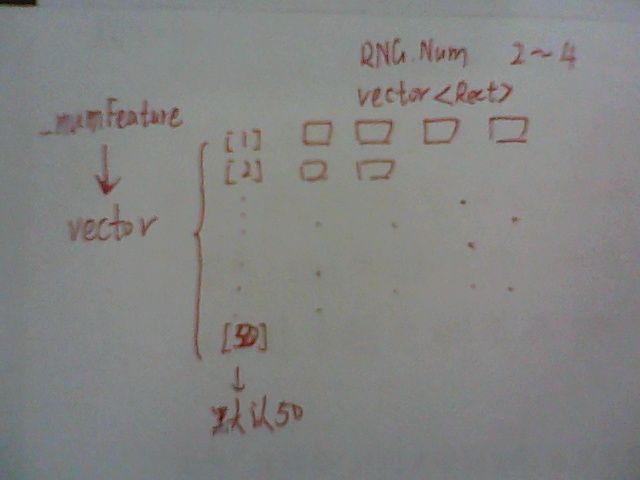CT-代码解释
转自:http://blog.csdn.net/sangni007/article/details/8116835
1.Description: compute Haar features(templates)
void CompressiveTracker::HaarFeature(Rect& _objectBox, int _numFeature)
在rect内取_numFeature维特征,(rect的宽高与_objectBox一样,与_objectBox.x _objectBox.y无关)
每一维Feature都用若干Rect表示,存在vector<vector<Rect>> feature (_numFeature, vector<Rect>())中,
相应权重 vector<vector<float>>featuresWeight(_numFeature, vector<float>())
2.Description: compute the coordinate of positive and negative sample image templates
void CompressiveTracker::sampleRect(Mat& _image, Rect& _objectBox, float _rInner, float _rOuter, int _maxSampleNum, vector<Rect>& _sampleBox)
随机洒出若干Rect,记录坐标Rect(x,y)
保证sampleRect的(x,y)到_objectBox的(x,y)的dist满足:_rOuter*_rOuter<dist<_rInner*_rInner
取样本:1:正:dist小;2:负:dist大:
存入_sampleBox
void CompressiveTracker::sampleRect(Mat& _image, Rect& _objectBox, float _srw, vector<Rect>& _sampleBox)
这个sampleRect的重载函数是用来,预测位置的
只要满足:dist<_rInner*_rInner
初始化第一帧不运行这个sampleRect的重载函数,只在跟踪时,首先运行它再更新正负样本函数;
3.Compute the features of samples
void CompressiveTracker::getFeatureValue(Mat& _imageIntegral, vector<Rect>& _sampleBox, Mat& _sampleFeatureValue)
计算相应Rect的积分图像的Sum值,存入Mat& _sampleFeatureValue(即特征值)

4.// Update the mean and variance of the gaussian classifier
void CompressiveTracker::classifierUpdate(Mat& _sampleFeatureValue, vector<float>& _mu, vector<float>& _sigma, float _learnRate)
计算每个上一步积分矩阵Mat& _sampleFeatureValue中每一SampleBox的期望和标准差
并Update(具体计算采用文章的公式[6])
5.// Compute the ratio classifier
void CompressiveTracker::radioClassifier(vector<float>& _muPos, vector<float>& _sigmaPos, vector<float>& _muNeg, vector<float>& _sigmaNeg, Mat& _sampleFeatureValue, float& _radioMax, int& _radioMaxIndex)
利用朴素贝叶斯分类(gaussian model)文章公式[4]
计算所有sample的贝叶斯值,用radioMax存储最大值,即为预测位置
Discussion
这篇文章最成功的地方在于简单高效,绝对可以达到实时跟踪的效果,之前实验的粒子滤波就显得太慢了;但是有很多问题需要改进。(个人观点和网友总结,欢迎拍砖~)
1.尺度问题,只能对单尺度操作,当对象远离时跟踪框依然大小不变;
2.关于压缩感知,可以改进,比如选择features pool 像随机森林一样选择最优特征;
3.偏向当前新样本,所以很容易就遗忘以前学习过的样本,一旦偏离,会越偏越远;
4.我也是刚研究tracking by detection不久,拜读了compressive tracking,感觉很有新意,用这么简洁的方法就能实现较好的效果,这篇论文的实验部分很像mil tracking,mil的弱分类器也是假设使用高斯分布,但是我实验的结果是 haar like 特征并不是很好的服从高斯分布,尤其是negative sample,所以在物体的表征变化很大的时候,这种representation不能很好的捕捉到,另外里面有个学习参数 lambda,这个参数的设置也是一个经验值,据我的经验,一般是偏向当前新样本,所以很容易就遗忘以前学习过的样本,TLD的随机森林fern是记录正负样本个数来计算posterior,这种方式在long time tracking比这个要好,另外TLD在每个细节上做得很好,它的更新模型也是有动态系统的理论支持。以上是个人拙见,希望能多交流。——老熊
5.如果在一些跟踪算法上面加些trick,也是可以做 long time tracking的。TLD 的trick就是用了第一帧的信息,其实这个信息很多时候是不太好的。并且这种trick多年前就有人用过了,不是TLD新创的。另外 TLD 的PAMI文章没有说这个trick,CVPR10文章说了。CT这个方法简单,它的侧重点不是说拼什么跟踪效果,主要是在理论方面说明一下问题——
